

List of Germanic deities. In Germanic paganism, the indigenous religion of the ancient Germanic peoples that inhabited Germanic Europe, there were a number of different gods and goddesses.
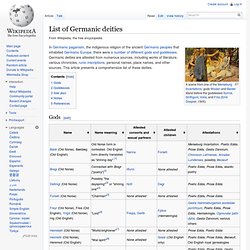
Germanic deities are attested from numerous sources, including works of literature, various chronicles, runic inscriptions, personal names, place names, and other sources. This article presents a comprehensive list of these deities. Gods[edit] Goddesses[edit] See also[edit] Notes[edit] References[edit] Bellows, Henry Adams (Trans.) (1936). Æsir. Loki. Loki, from an 18th-century Icelandic manuscript In both the Poetic Edda and the Prose Edda, the goddess Skaði is responsible for placing a serpent above him while he is bound.
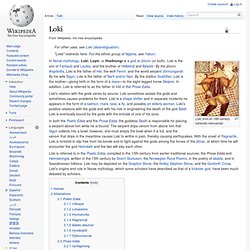
The serpent drips venom from above him that Sigyn collects into a bowl; however, she must empty the bowl when it is full, and the venom that drips in the meantime causes Loki to writhe in pain, thereby causing earthquakes. Thor. In Norse mythology, Thor (/θɔr/; from Old Norse Þórr) is a hammer-wielding god associated with thunder, lightning, storms, oak trees, strength, the protection of mankind, and also hallowing, healing and fertility.
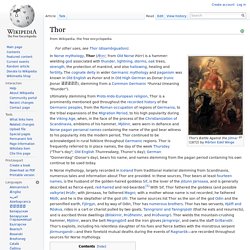
The cognate deity in wider Germanic mythology and paganism was known in Old English as Þunor and in Old High German as Donar (runic þonar ᚦᛟᚾᚨᚱ), stemming from a Common Germanic *Þunraz (meaning "thunder"). Heimdallr. Heimdallr brings forth the gift of the gods to mankind (1907) by Nils Asplund In Norse mythology, Heimdallr is a god who possesses the resounding horn Gjallarhorn, owns the golden-maned horse Gulltoppr, has gold teeth, and is the son of Nine Mothers.
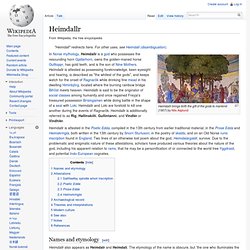
Heimdallr is attested as possessing foreknowledge, keen eyesight and hearing, is described as "the whitest of the gods", and keeps watch for the onset of Ragnarök while drinking fine mead in his dwelling Himinbjörg, located where the burning rainbow bridge Bifröst meets heaven. Heimdallr is said to be the originator of social classes among humanity and once regained Freyja's treasured possession Brísingamen while doing battle in the shape of a seal with Loki.
Heimdallr and Loki are foretold to kill one another during the events of Ragnarök. Odin. Etymology[edit] Odin's name is formed from "óðr" and the suffix "-inn".

Old Norse had two different words spelled óðr, one an adjective and the other a noun. The adjective means "mad, frantic, furious, violent",[3] and is cognate with Old English wōd (hence the anglo-saxon Wōden).[4] The noun means "mind, wit, soul, sense" and "song, poetry".[5] Origin[edit] The 7th century Tängelgarda stone shows Odin leading a troop of warriors all bearing rings; Valknut symbols are drawn beneath his horse, which is depicted with four legs Originally, Odin was possibly considered mainly a shamanistic god and the leader of the war band. Valkyrie. In Norse mythology, a valkyrie (from Old Norse valkyrja "chooser of the slain") is one of a host of female figures who decide which soldiers die in battle and which live.
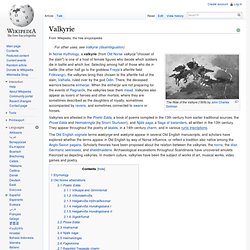
Hávamál. Hávamál (English pronunciation: /ˈhɑːvəmɑːl/ HAH-və-mahl; "sayings of the high one") is presented as a single poem in the Poetic Edda, a collection of Old Norse poems from the Viking age.

The poem, itself a combination of different poems, is largely gnomic, presenting advice for living, proper conduct and wisdom. The verses are attributed to Odin, much like the biblical Book of Wisdom is attributed to Solomon. The implicit attribution to Odin facilitated the accretion of various mythological material also dealing with Odin.[1] Textual history[edit] The only surviving source for Hávamál is the 13th century Codex Regius. To the gnomic core of the poem, other fragments and poems dealing with wisdom and proverbs accreted over time. Structure[edit] The Hávamál is edited in 165 stanzas by Bellows (1936). The poems in Hávamál is traditionally taken to consist of at least five independent parts, Stanzas 81-84 are in málaháttr, 85-88 in fornyrðislag. Contents[edit] Runic alphabet.
Runology is the study of the runic alphabets, runic inscriptions, runestones, and their history. Runology forms a specialised branch of Germanic linguistics. The earliest runic inscriptions date from around AD 150. The characters were generally replaced by the Latin alphabet as the cultures that had used runes underwent Christianisation, by approximately AD 700 in central Europe and AD 1100 in Northern Europe. However, the use of runes persisted for specialized purposes in Northern Europe. Until the early 20th century, runes were used in rural Sweden for decorative purposes in Dalarna and on Runic calendars. The three best-known runic alphabets are the Elder Futhark (around AD 150–800), the Anglo-Saxon Futhorc (AD 400–1100), and the Younger Futhark (AD 800–1100). Vanir. Frigg. In the Poetic Edda poem Lokasenna 26, Frigg is said to be Fjörgyns mær ("Fjörgynn's maiden").

The problem is that in Old Norse mær means both "daughter" and "wife," so it is not fully clear if Fjörgynn is Frigg's father or another name for her husband Odin, but Snorri Sturluson interprets the line as meaning Frigg is Fjörgynn's daughter (Skáldskaparmál 27), and most modern translators of the Poetic Edda follow Snorri. The original meaning[dubious ] of fjörgynn was the earth, cf. feminine version Fjorgyn, a byname for Jörð, the earth. The other piece of evidence lies with the goddess Fjorgyn, who is the mother of Thor, and whose name can be translated into Earth. Since Fjorgyn is not only the name of a goddess, but the feminine byname for Earth, it is relatively safe to assume that "mær", in this case, means "daughter".[4] Etymology[edit] Attributes[edit] Frigg's name means "love" or "beloved one" (Proto-Germanic *frijjō, cf.
Frigg was a goddess associated with married women. Sif. In Norse mythology, Sif is a goddess associated with earth.
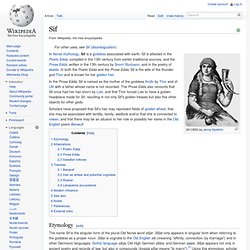
Freyja. In Norse mythology, Freyja (Old Norse the "Lady") is a goddess associated with love, sexuality, beauty, fertility, gold, seiðr, war, and death.
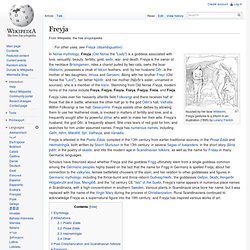
Freyja is the owner of the necklace Brísingamen, rides a chariot pulled by two cats, owns the boar Hildisvíni, possesses a cloak of falcon feathers, and, by her husband Óðr, is the mother of two daughters, Hnoss and Gersemi. Along with her brother Freyr (Old Norse the "Lord"), her father Njörðr, and her mother (Njörðr's sister, unnamed in sources), she is a member of the Vanir. Stemming from Old Norse Freyja, modern forms of the name include Freya, Frejya, Freyia, Frøya, Frøjya, Freia, and Freja. Freyja rules over her heavenly afterlife field Fólkvangr and there receives half of those that die in battle, whereas the other half go to the god Odin's hall, Valhalla. Within Fólkvangr is her hall, Sessrúmnir. Etymology[edit] Attestations[edit] Poetic Edda[edit] Freyja and Loki flyt in an illustration (1895) by Lorenz Frølich.